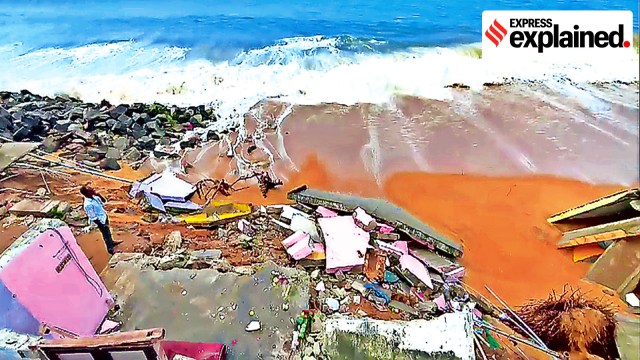- India
- International
What is Kallakkadal, which has flooded houses in Kerala’s coastal areas?
Such flooding events are called swell surge or Kallakkadal in Malayalam. Here is a look at the phenomenon, why it happens, and how it is different from a tsunami.
 Houses damaged due to a Kallakkadal event in Kollam on Tuesday. ANI
Houses damaged due to a Kallakkadal event in Kollam on Tuesday. ANIHundreds of houses have been flooded in several coastal areas of Kerala due to high sea waves, also known as swell waves, since Sunday (March 31). The worst affected regions include Alappuzha, Kollam, and Thiruvananthapuram districts. Authorities have opened relief camps for the affected local communities. Such flooding events are called swell surge or Kallakkadal in Malayalam.
Here is a look at the phenomenon, why it happens, and how it is different from a tsunami.
What is Kallakkadal?
Kallakkadal is essentially coastal flooding during the pre-monsoon (April-May) season by swell waves on the southwest coast of India, according to a paper, Teleconnection between the North Indian Ocean high swell events and meteorological conditions over the Southern Indian Ocean, which was published in the journal AGU in 2016. The study was authored by P G Remya, S Vishnu, B Praveen Kumar, T M Balakrishnan Nair, and B Rohith — all from the Indian National Centre for Ocean Information Services, Hyderabad.
The term Kallakkadal, used by local fishermen, is a combination of two Malayalam words, including Kallan and Kadal. “Kallan means thief and Kadal means sea. In spoken language, these words were combined and pronounced as Kallakkadal, meaning ocean that arrives as a thief,” the study said. In 2012, the term was formally approved by the United Nations Educational, Scientific and Cultural Organization (UNESCO).
What causes Kallakkadal?
Kallakkadal is caused by waves that are formed by an ocean swell, hence the name swell surge. Ocean swells occur not due to the local winds, but rather due to distant storms like hurricanes, or even long periods of fierce gale winds. During such storms, huge energy transfer takes place from the air into the water, leading to the formation of very high waves. Such waves can travel thousands of kilometres from the storm centre until they strike shore.

Usually, Kallakkadal is a consequence of the strong winds in the southern part of the Indian Ocean, where an ocean swell is generated, and the waves then travel north to reach the coast in two or three days.
The latest instance took place after a low atmospheric pressure system moved over the region around March 25 from the South Atlantic Ocean — 10,000 kilometres off the Indian coast. The arrival of the pressure system resulted in strong winds, which led to the formation of swell waves of up to 11 metres in height. These waves have been hitting the Kerala coast and Lakshadweep since Sunday.
Kallakkadal occurs without precursors or any kind of local wind activity and as a result, it has been very difficult for the coastal population to get an advance warning. However, early warning systems like the Swell Surge Forecast System —launched by the Indian National Centre for Ocean Information Services (INCOIS) in 2020 — give forewaring seven days in advance.
Why is Kallakkadal different from tsunami?
Kallakkadal came under the spotlight after the 2004 tsunami that killed more than 10,000 people. However, Kallakkadal is often mistaken to be a tsunami, which is a series of enormous waves created by an underwater disturbance usually associated with earthquakes occurring below or near the ocean.
What is the forecast?
The swell surge is likely to continue impacting Kerala and other western coast regions of the country for the next two days before they gradually weaken.
INCOIS has stated high waves will move to the Tamil Nadu coast on Tuesday night. It has alerted people in coastal areas vulnerable to sea erosion to take precautionary steps and ensure the safety of fishing vessels.
More Explained
EXPRESS OPINION
Apr 04: Latest News
- 01
- 02
- 03
- 04
- 05































